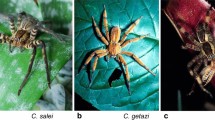Summary
There is a sexual dimorphism in the frequency of the quasi-sinusoidal electric organ discharge (EOD) of Sternopygus macrurus, with males, on average, an octave lower. EODs are detected by tuberous electroreceptor organs, which exhibit V-shaped frequency tuning with maximal sensitivity near the fish's own EOD frequency. This would seem to limit the ability of a fish to detect the EODs of opposite-sex conspecifics. However, electroreceptor tuning has always been based on single-frequency stimulation, while actual EOD detection involves the addition of a conspecific EOD to the fish's own. In the present study, recordings were made from single electroreceptive units while the fish were stimulated with pairs of sine waves: one (S1) representing the fish's own EOD added to a second (S2) representing a conspecific EOD. T unit response was easily predicted by assuming that the electroreceptor acts as a linear filter in series with a threshold-sensitive spike initiator. P unit response was more complex, and unexpectedly high sensitivity was found for frequencies of S2 well displaced from the fish's EOD frequency. For both P and T units, detection thresholds for S2 were much lower when added to S1, than when presented alone.
Similar content being viewed by others
Abbreviations
- EOD :
-
electric organ discharge
- BF:
-
best frequency
- JAR :
-
jamming avoidance response
References
Bastian J, Heiligenberg W (1980) Neural correlates of the jamming avoidance response in Eigenmannia. J Comp Physiol 136:135–152
Bullock TH, Chichibu S (1965) Further analysis of sensory coding in electroreceptors of electric fish. Proc Natl Acad Sci USA 54:422–429
Carr CE, Heiligenberg W, Rose GJ (1986) A time comparison circuit in the electric fish midbrain I. Behavior and physiology. J Neurosci 6:107–119
Feng AS, Bullock TH (1977) Neuronal mechanisms for object discrimination in the weakly electric fish, Eigenmannia virescens. J Exp Biol 66:141–158
Fleishman LJ, Zakon HH (1989) Peripheral filtering and communication in the weakly electric fish Sternopygus. In: Erber H, Menzel R, Pflüger H-J, Todt D (eds) Neural mechanisms of behavior: proceedings of the 2nd International Congress of Neuroethology, Thieme, Stuttgart New York, p 93a
Fleishman LJ, Zakon HH, Lemon WC (1992) Communication in the weakly electric fish Sternopygus macmrus. II: Behavioral test of conspecific EOD detection ability. J Comp Physiol A 170:349–356
Hagedorn M (1986) The ecology, courtship, and mating of gymnotiform electric fish. In: Bullock TH, Heiligenberg W (eds) Electroreception. Wiley, New York, pp 497–525
Heiligenberg W (1986) Jamming avoidance responses: model systems for neuroethology. In: Bullock TH, Heiligenberg W (eds) Electroreception. Wiley, New York, pp 613–649
Heiligenberg W, Altes RA (1978) Phase sensitivity in electroreception. Science 199:1001–1004
Heiligenberg W, Partridge BL (1981) How electroreceptors encode JAR-eliciting stimulus regimes: reading trajectories in a phase-amplitude plane. J Comp Physiol 142:295–308
Hopkins CD (1972) Sex differences in electric signalling in an electric fish. Science 176:1035–1037
Hopkins CD (1974) Electric communication in the reproductive behavior of Sternopygus macrurus (Gymnotoidei). Z Tierpsychol 35:518–535
Hopkins CD (1976) Stimulus filtering and electroreception: tuberous electroreceptors in three species of gymnotoid fish. J Comp Physiol 111:171–207
Hopkins CD (1980) Evolution of electric communication channels of mormyrids. Behav Ecol Sociobiol 7:1–13
Hopkins CD, Harned GD (1987) White noise analysis predicts temporal spike pattern of tuberous electroreceptors in mormyrid electric fish. Soc Neurosci Abstr 13(1): 621
Knudsen EI (1974) Behavioral thresholds to electric signals in high frequency electric fish. J Comp Physiol 91:333–353
Knudsen EI (1975) Spatial aspects of the electric fields generated by weakly electric fish. J Comp Physiol 99:103–118
Rose GJ, Canfield JG (1991) Discrimination of the sign of frequency differences by Sternopygus, an electric fish without a jamming avoidance response. J Comp Physiol A 168:461–467
Rose G, Keller C, Heiligenberg W (1987) “Ancestral” neural mechanisms of electrolocation suggest a substrate for the evolution of the jamming avoidance response. J Comp Physiol A 160:491–500
Sanchez DY (1988) The effects of postembryonic receptor cell addition on response properties of afferents in the electrosensory system of Sternopygus macrurus. PhD Thesis, Univ Texas, Austin, Tx
Sanchez DY, Zakon HH (1990) The effects of postembryonic receptor cell addition on the response properties of electroreceptive afferents. J Neurosci 10:361–369
Scheich H, Bullock TH, Hamstra RH (1973) Coding properties of two classes of afferent nerve fibers: high frequency electroreceptors in the electric fish Eigenmannia. J Neurophysiol 36:39–60
Viancour TA (1979) Electroreceptors of a weakly electric fish I: characterization of tuberous receptor organ tuning. J Comp Physiol 133:317–325
Zakon HH (1984) Postembryonic changes in the peripheral electrosensory system of a weakly electric fish: addition of receptor organs with age. J Comp Neurol 228:557–570
Zakon HH (1986) The electroreceptive periphery. In: Bullock TH, Heiligenberg W (eds) Electroreception. Wiley, New York, pp 103–156
Zakon HH, Meyer JH (1983) Plasticity of electroreceptor tuning in the weakly electric fish Sternopygus dariensis. J Comp Physiol 153:477–487
Zar JH (1974) Biostatistical analysis. Prentice-Hall, Englewood Cliffs, New Jersey
Author information
Authors and Affiliations
Rights and permissions
About this article
Cite this article
Fleishman, L.J. Communication in the weakly electric fish Sternopygus macrurus . J Comp Physiol A 170, 335–348 (1992). https://doi.org/10.1007/BF00191422
Accepted:
Issue Date:
DOI: https://doi.org/10.1007/BF00191422




